
Wine Culture and Information since 2002 - Volume 22
 Wine Culture and Information since 2002 - Volume 22 |
|
NebbioloThe grape from which are being produced two great wines of Piedmont - Barolo and Barbaresco - is very appreciated in Italy as well as in other countries of the world for the elegance and personality of its wines |
|
Whenever important grapes are being mentioned, most of the times are the French ones - the so called international grapes - to be mainly remembered, indeed even in Italy - among the many and good grapes of this country - there is one grape that since more than a century belongs to this narrow and prestigious category. Nebbiolo - whose wines are frequently defined as “wines of the kings” as well as “king of wines” - is almost and exclusively associated to its homeland - Piedmont and in particular Langhe - however it is also found in other regions of northern Italy and, marginally, in other countries of the world. The main representatives of this grape certainly are Barolo and Barbaresco - two wines which owe their fame and quality both to their areas of origin and to Nebbiolo - as well as wines from Valtellina in Lombardy and the ones from the northern part of Piedmont and Vallée d'Aoste. The Nebbiolo grape originated from Piedmont and despite it is not the most cultivated grape in terms of quantity, it certainly is the most precious and celebrated one of this region. There are written documents about Nebbiolo dated back to 1200's and it is however certain this grape was known in ancient times; moreover it was probably mentioned by Pliny the Elder as well. The origin of its name certainly comes from the word nebbia (Italian for fog), a meteorological condition frequent in Piedmont during autumn when harvesting takes place. Nebbiolo is therefore a grape reaching full ripeness - and therefore it is ready for harvesting - when in autumn, frequently after the half of October, vineyards are covered by fog. Indeed Nebbiolo is a variety which ripens later in regard to other varieties, another factor which certainly confirms the origin of its name.
Nebbiolo is a pretty “bizarre” and exacting grape in terms of environmental and climate conditions, a characteristic which probably limited its spreading beyond the borders of Piedmont and however of Italy. Even in Piedmont its cultivation is pretty limited as well as limited are the areas in which this grape is capable of giving its best for the production of great wines. Because of its relatively late ripening, Nebbiolo is generally cultivated in hills facing towards south or south-west in which the type of soil plays a role of primary importance. Nebbiolo prefers soils rich in limestone and marl sediments - such as the ones in some areas near Barolo, Barbaresco and Alba - capable of developing in wines complex aromas and an excellent balance between acidity and tannins. In case it is being cultivated in sandy soils - such as the ones in the Roero area - the wines get a more delicate, smooth and less harsh character. Despite Nebbiolo is a pretty ancient grape cultivated in Piedmont since many centuries, its success is strictly connected to Barolo and, more precisely, to the recent history of Barolo. Until the half of 1800's wines produced with Nebbiolo grape - because of low temperatures typical of the harvesting time which interrupted fermentation - had a pretty sweet taste, very distant from the renowned wines of those times, such as the ones produced in Bordeaux and Bourgogne. Around the half of 1800's Marquise Giulietta Falletti of Barolo asked the famous French wine maker Louis Oudart, called in the Langhe area by Count Camillo Benso of Cavour, to improve the wines of her cellar. After a brief investigation, the famous wine maker individuated the cause in the approximate production techniques: the fermentation process could not come to an end and therefore the wine remained unstable, with a sweetish flavors and to be drunk as soon as possible. His results convinced Cavour to ask Oudart for his intervention in the cellar at his castle at Grinzane and even King Vittorio Emanuele II converted his hunting lodge in Fontanafredda, at Serralunga d'Alba, to the production of this new wine. Barolo was born, the wine which made famous both Piedmont and Nebbiolo, an event which gave a strong impulse to the modern Italian enology. Since then, the production of Barolo - and of wines made of Nebbiolo - has evolved and changed according to modern technologies as opposed to the ones of the past. This led to the formation of two schools of thought - in particular in Piedmont - generally defined as traditionalists and modernists. Traditionalists support the idea Nebbiolo, and in particular Barolo, should be made according to traditional principles by allowing long fermentation and aging times for three or four years in large casks of Slovenian oak or chestnut wood. Modernists support the idea Nebbiolo must be aged in French oak barriques in order to make it smoother and less harsh, and in the aim of making it a more immediate wine, fresh as well as keeping its fruity character. These two new visions of making Nebbiolo have also been the origin of many followers for one or the other school of thought, sometimes cause of strong debates and arguments not only among producers but also among consumers. The vision of “traditionalists” and of “modernists” are also visible in the wine appearance, where in the first case it shows paler colors and higher transparencies, and in the second case the intensity of color is higher and the transparency is lesser. Despite the spreading of Nebbiolo is pretty limited, in every area in which it is being cultivated it is called with a characteristic name: in the northern area of Piedmont - in particular at Carema - and in the Vallée d'Aoste, Nebbiolo is called Picutener, whereas in the areas of Gattinara and Ghemme it is called Spanna. In Valtellina - Lombardy - the Nebbiolo grape used for the renowned red wines of the area is called Chiavennasca. Nebbiolo is known to have three clonal varieties: Lampia, Michet and Rosé. The most famous one of the three is Lampia, whereas Michet is the Lampia variety affected by a virus which causes the bifurcation of branches. The Michet variety tends to a lower yield and its grapes have more intense and aromatic qualities, however it has a lesser capacity of adaptation in different soil types. The Rosé is rapidly declining because of its lesser coloring capacity with the result of producing pretty pale wines. Quality wines produced with Nebbiolo have a high acidity and alcohol, as well as a high quantity of tannins: all these factors ensure long aging times, frequently more than twenty years.
|
||||||||
|
Nebbiolo grape does not have huge quantities of colorants, therefore in its wines it will be hardly possible to see extremely intense colors and low transparencies. Nebbiolo can be considered as a grape having an average coloring capacity, moreover the color of its wines strongly depends on the way they were produced. In wines produced according to the traditional method, that is with long maceration times and long aging times in Slovenian oak casks or chestnut wood, the color is pretty pale and the aspect is transparent, with garnet red hues and sometimes brick orange. In Nebbiolo wines produced with modern systems, the extraction of color is greatly encouraged and the transparency is lower. Wines produced with Nebbiolo grapes tend to change their color pretty rapidly and after few years it is possible to see evident nuances of brick orange, a color generally typical in wines which reached the apex of aging. This characteristic is to be considered normal for Nebbiolo, therefore - in this specific case - a wine showing a brick orange color must not be considered as “old”. It is useful to remember Nebbiolo generally has a remarkable capacity of aging which can also be more than twenty years.
|
|
The aromas of wines made with Nebbiolo grape are pretty characteristic, however it is good to remember - as opposed to other varieties - these aromas can be easily covered by the use of new casks, in particular new barriques with strong toasting. The use of barrique with Nebbiolo is one of the subject from which originated many debates between modernists and traditionalists and according to the latter, the nature of Nebbiolo is strongly altered. Wines produced with this grape can be recognized in their youth because of the strong aromas of cherry, plum and - in particular - of violet, whereas with aging in bottle - and it is good to remember Nebbiolo can require even ten years to reach maturity - are being developed very complex aromas such as tar, truffle, mushrooms, leather and smoke. In the so called traditional Nebbiolo aged in large casks, the impact of aromas derived from wood is pretty low while favoring the typical qualities of these wines, whereas in modern Nebbiolo aged in barrique or small barrels, the aromas of vanilla and toasted - typically passed by wood - can sometimes cover the nature of Nebbiolo. As always it is a matter of balance and of personal taste: the use of wood is simply one of the many factors - and Nebbiolo is no exception - which contributes to the harmony and balance of a wine. It is however indisputable there are great traditional Nebbiolos as well as great modern Nebbiolos. In wines produced with grapes cultivated in cool areas or not having reached full ripeness, the aromas which mainly develop resemble flowers - in which it is found the typical violet - as well as aromas of fruit such as cherry, strawberry, raspberry; sometimes it can also be perceived the aroma of white pepper. In wines produced with Nebbiolo cultivated in warmer areas or with fully ripe grapes, it is found the typical aroma of violet, to which is added a pleasing aroma of rose, and aromas of fruit resembling black cherry or ripe cherry, plum and sometimes blackberry, as well as mineral aromas. Nebbiolo becomes particularly amazing after a proper time of aging in bottle. With aging the fruit aromas of Nebbiolo are transformed into rich jams, emerges the aroma of dried rose and violet. Time gives Nebbiolo other extremely complex and elegant aromas such as tar, leather, truffle, mushrooms and smoke, in which it is always possible to perceive its typical aromas of flowers and fruits.
|
||||
|
Nebbiolo shows its strong personality even in the taste. The wines produced with this grape are characterized by a strong acidity, are pretty alcoholic and rich in harsh tannins, however elegant and refined. These three qualities - combined together - ensure Nebbiolo wines very long aging times in bottle, most of the times more than twenty years. Nebbiolo makes wines of remarkable structure - in particular for the quantity of tannins - even though its appearance could make anyone think of the opposite. The aspect of Nebbiolo can look like a light wine, indeed after the first sip has been tasted, it is ready to reveal his power, most of the times surprising. The first impact is constituted by a pretty high acidity which only an adequate quantity of alcohol can keep in balance. Even astringency will be pretty evident, however in mature Nebbiolo this sensation will be milder and smoother, while keeping its nature and surprising elegance. Even in this case the high quantity of alcohol in these wines will be indispensable in order to obtain a perfect balance.
|
|
Nebbiolo is mainly associated to Piedmont - its homeland - and despite it is not the most cultivated variety in terms of quantity, it certainly is the most important and renowned grape. The most emblematic wines produced with Nebbiolo have always been Barolo and Barbaresco, two wines which are strongly connected to the grape and to Piedmont. Barbaresco is usually considered as a more gentle and feminine version of Barolo, a wine which has always had the reputation of a more austere and masculine nature. Indeed this difference is not always confirmed by reality because the nature of the two wines is strongly influenced both by the environmental conditions of vineyards as well as by the production style. Whatever the difference, Barolo and Barbaresco are two magnificent wines, worth representatives of this grape. Nebbiolo is very common in the Langhe area, in the territory of Alba and in the Roero area and it is virtually found in every red wine of these areas. Wines produced in these areas - usually having a cost lesser than Barolo and Barbaresco - represent a very good reference point for understanding Nebbiolo and among the many are mentioned Nebbiolo d'Alba, Langhe Nebbiolo and Roero. Nebbiolo is also cultivated in the northern part of Piedmont and it is the main grape in Carema, Gattinara and Ghemme wines. Wines from Carema are produced with Nebbiolo only - here known as Spanna or Picutener - whereas in wines of Gattinara and Ghemme, Nebbiolo is usually blended with other local grapes. Other wines from Piedmont in which is found Nebbiolo include: Boca, Sizzano, Bramaterra, Canavese, Fara and Lessona. Outside the borders of Piedmont, Nebbiolo is found in Vallée d'Aoste - here known as Picoutener or Picotendro - in particular for the production of Donnas wines. Another important area for Nebbiolo is Valtellina - in the northern part of Lombardy - where the grape is known as Chiavennasca. In Lombardy Nebbiolo is also used in the Franciacorta area where it is being used - together with other grapes - for the production of red wines. Despite its magnificence, Nebbiolo did not spread outside Italy which in past times was introduced by emigrants in the American continent and in Australia. Nebbiolo is cultivated - although in limited quantities - in California and near San Juan in Argentina, and more marginally, at Victoria in Australia.
|
Wines of the Month |
|
|
|
Score legend Prices are to be considered as indicative. Prices may vary according to the country or the shop where wines are bought |
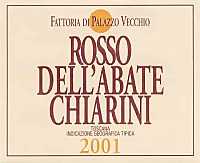
|
|
Rosso dell'Abate Chiarini 2001 |
|
| Fattoria di Palazzo Vecchio (Italy) | |
| Grapes: Sangiovese (70%), Merlot (30%) | |
| Price: € 11.00 | Score: |
| The wine shows a brilliant ruby red color and nuances of garnet red, little transparency. The nose reveals intense, clean, pleasing, refined and elegant aromas that start with hints of black cherry and violet followed by aromas of blueberry, blackberry, plum, vanilla, licorice, carob, mace and menthol. In the mouth has good correspondence to the nose, a slightly tannic attack and pleasing crispness, however balanced, full body, intense flavors, good tannins. The finish is persistent with flavors of plum and black cherry. This wine ages for 24 months in cask followed by 10 months of aging in bottle. | |
| Food Match: Braised and stewed meat, Game, Roasted meat, Hard cheese | |
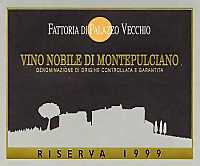
|
|
Vino Nobile di Montepulciano Riserva 1999 |
|
| Fattoria di Palazzo Vecchio (Italy) | |
| Grapes: Prugnolo Gentile (90%), Canaiolo Nero (10%) | |
| Price: € 18.00 | Score: |
| This Nobile shows a brilliant ruby red color and nuances of garnet red, little transparency. The nose reveals intense, clean, pleasing, refined and elegant aromas that start with hints of blackberry jam and raspberry jam followed by aromas of black cherry jam, plum jam, dried violet, licorice, tobacco, vanilla, carob and cinnamon. In the mouth has good correspondence to the nose, a slightly tannic attack and however balanced by alcohol, full body, intense flavors, good tannins. The finish is persistent with flavors of black cherry jam and raspberry jam. A well made wine. This reserve of Nobile di Montepulciano ages for 24 months in cask followed by 10 months of aging in bottle. | |
| Food Match: Braised and stewed meat, Roasted meat, Game, Hard cheese | |
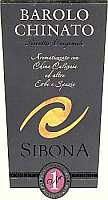
|
|
Barolo Chinato |
|
| Sibona (Italy) | |
| Grapes: Nebbiolo | |
| Price: € 20.00 - 50cl | Score: |
| This wine shows a pale garnet red color and nuances of brick red, moderate transparency. The nose denotes intense, clean, pleasing and refined aromas which start with hints of cinchona and plum jam followed by aromas of cinnamon, gentian, rhubarb, star anise and black pepper. In the mouth has good correspondence to the nose, a sweet and slightly tannic attack, however balanced, full body, intense flavors, agreeable. The finish is persistent with flavors of cinchona, gentian and rhubarb. This Barolo is aromatized with cinchona, aromatic herbs and spices. | |
| Food Match: Chocolate, Dried fruit tarts, Strudel | |
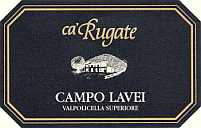
|
|
Valpolicella Superiore Campo Lavei 2002 |
|
| Ca' Rugate (Italy) | |
| Grapes: Corvina (40%), Rondinella (30%), Corvinone (30%) | |
| Price: € 13.30 | Score: |
| The wine shows a brilliant ruby red color and nuances of garnet red, moderate transparency. The nose reveals intense, clean, pleasing and refined aromas which start with hints of black cherry, blackberry and plum followed by aromas of violet, vanilla, tobacco, licorice, cinnamon and hints of menthol. In the mouth has good correspondence to the nose, a slightly tannic attack and however balanced by alcohol, good body, intense flavors, good tannins, agreeable. The finish is persistent with flavors of plum and black cherry. A well made wine. This Valpolicella ages in cask for 8-10 months. | |
| Food Match: Broiled meat and barbecue, Roasted meat, Braised and stewed meat, Hard cheese | |
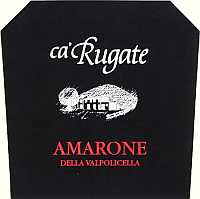
|
|
Amarone della Valpolicella 2001 |
|
| Ca' Rugate (Italy) | |
| Grapes: Corvina (40%), Rondinella (30%), Corvinone (30%) | |
| Price: € 37.80 | Score: |
| This Amarone shows an intense ruby red color and nuances of garnet red, little transparency. The nose reveals intense, clean, pleasing, refined and elegant aromas which start with hints of blackberry and black cherry followed by aromas of raspberry, plum, black currant, blueberry, dried violet, licorice, vanilla, enamel, chocolate, mace, pink pepper and hints of menthol. In the mouth has very good correspondence to the nose, a tannic attack and however well balanced by alcohol, full body, intense flavors, good tannins, agreeable. The finish is persistent with good flavors of blackberry, plum and black cherry. A well made wine. This Amarone ages in cask for about 25-30 months. | |
| Food Match: Game, Roasted meat, Braised and stewed meat, Hard cheese | |
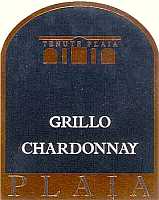
|
|
Plaia Grillo - Chardonnay 2003 |
|
| Plaia (Italy) | |
| Grapes: Grillo (70%), Chardonnay (30%) | |
| Price: € 10.00 | Score: |
| This wine shows an intense straw yellow color and nuances of straw yellow, very transparent. The nose reveals intense, clean, pleasing and refined aromas which start with hints of pineapple, pear and apple followed by aromas of hawthorn, broom, banana, peach and plum. In the mouth has good correspondence to the nose, a crisp attack and however balanced by alcohol, good body, intense flavors. The finish is persistent with flavors of plum, apple and pear. | |
| Food Match: Broiled fish, Roasted fish, Pasta and risotto with fish | |
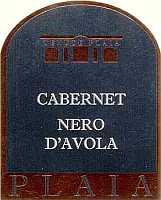
|
|
Plaia Cabernet - Nero d'Avola 2002 |
|
| Plaia (Italy) | |
| Grapes: Cabernet Sauvignon (50%), Nero d'Avola (30%), Syrah (20%) | |
| Price: € 13.00 | Score: |
| This wine shows an intense ruby red color and nuances of ruby red, little transparency. The nose reveals intense, clean and pleasing aromas which start with hints of blackberry and plum jam followed by aromas of black cherry, bell pepper, violet, licorice and carob. In the mouth has good correspondence to the nose, a slightly tannic attack and however balanced, good body, intense flavors. The finish is persistent with flavors of blackberry and black cherry. This wine ages in barrique. | |
| Food Match: Roasted meat, Braised and stewed meat, Hard cheese | |
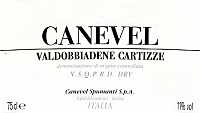
|
|
Prosecco di Valdobbiadene Dry Superiore di Cartizze 2003 |
|
| Canevel (Italy) | |
| Grapes: Prosecco | |
| Price: € 13.30 | Score: |
| This Prosecco shows a brilliant greenish yellow color and greenish yellow nuances, very transparent, fine and persistent perlage. The nose reveals clean and pleasing aromas that start with hints of peach and acacia followed by aromas of hawthorn, broom, wistaria, apple, pear and hints of litchi. In the mouth has good correspondence to the nose, an effervescent and crisp attack with slight and pleasing sweetness, however balanced, delicate, intense flavors, agreeable. The finish is persistent with flavors of pear, apple and peach. This Prosecco Cartizze is produced with the Martinotti method. | |
| Food Match: Dairy products, Semifreddo, Cream desserts | |

|
|
Prosecco di Valdobbiadene Extra Dry Il Millesimato 2003 |
|
| Canevel (Italy) | |
| Grapes: Prosecco | |
| Price: € 9.20 | Score: |
| This Prosecco shows a brilliant greenish yellow color and nuances of greenish yellow, very transparent, fine and persistent perlage. The nose reveals intense, clean, pleasing and refined aromas which start with hints of pear, apple and yeast followed by aromas of hawthorn, bread crust, almond, peach and pineapple. In the mouth has good correspondence to the nose, an effervescent and crisp attack, however balanced, good body, intense flavors, agreeable. The finish is persistent with flavors of peach, pear and apple. This Prosecco is produced with the Martinotti method. | |
| Food Match: Dairy products, Pasta and risotto with fish and crustaceans, Broiled crustaceans | |
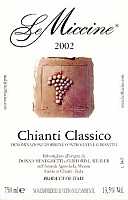
|
|
Chianti Classico 2002 |
|
| Le Miccine (Italy) | |
| Grapes: Sangiovese (95%), Malvasia Nera, Canaiolo Nero (5%) | |
| Price: € 13.00 | Score: |
| The wine shows an intense ruby red color and nuances of ruby red, moderate transparency. The nose denotes intense, clean and pleasing aromas that start with hints of black cherry and plum followed by aromas of blueberry, violet, vanilla, licorice, tobacco and carob. In the mouth has good correspondence to the nose, a slightly tannic attack and however balanced by alcohol, good body, intense flavors, good tannins. The finish is persistent with flavors of black cherry and plum. This Chianti ages for 9 months in cask followed by at least 6 months of aging in bottle. | |
| Food Match: Sauteed meat, Broiled meat and barbecue, Roasted meat, Stewed meat with mushrooms | |
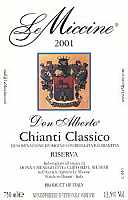
|
|
Chianti Classico Riserva Don Alberto 2001 |
|
| Le Miccine (Italy) | |
| Grapes: Sangiovese | |
| Price: € 21.00 | Score: |
| This Chianti shows a brilliant ruby red color and nuances of ruby red, moderate transparency. The nose denotes intense, clean, pleasing and refined aromas which start with hints of black cherry and raspberry followed by aromas of blueberry, plum, cyclamen, dried violet, vanilla and licorice. In the mouth has good correspondence to the nose, a slightly tannic attack and pleasing crispness, however balanced by alcohol, full body, intense flavors, good tannins. The finish is persistent with flavors of black cherry, raspberry and plum. This Chianti ages for 21 months in cask followed by 12 months of aging in bottle. | |
| Food Match: Roasted meat, Braised and stewed meat, Broiled meat and barbecue, Hard cheese | |
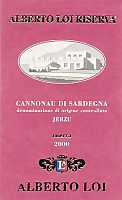
|
|
Cannonau di Sardegna Jerzu Riserva Alberto Loi 2000 |
|
| Alberto Loi (Italy) | |
| Grapes: Cannonau | |
| Price: € 10.80 | Score: |
| The wine shows a brilliant ruby red color and nuances of garnet red, moderate transparency. The nose reveals intense, clean, pleasing and refined aromas which start with hints of black cherry and plum followed by aromas of violet, vanilla, blueberry, licorice, cinnamon, chocolate and hints of menthol. In the mouth has good correspondence to the nose, a slightly tannic attack and however balanced by alcohol, good body, intense flavors, good tannins. The finish is persistent with flavors of black cherry and plum. This Cannonau ages for 12-14 months in cask, 4 months in barrique and 8 months in bottle. | |
| Food Match: Roasted meat, Broiled meat and barbecue, Stewed meat, Hard cheese | |
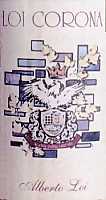
|
|
Loi Corona 2000 |
|
| Alberto Loi (Italy) | |
| Grapes: Cannonau (70%) | |
| Price: € 22.80 | Score: |
| This wine shows a brilliant ruby red color and nuances of garnet red, moderate transparency. The nose has good personality with intense, clean, pleasing, refined and elegant aromas which start with hints of cherry and plum jam followed by aromas of strawberry jam, raspberry jam, blueberry jam, vanilla, dried violet, licorice, tobacco, carob and cinnamon. In the mouth has good correspondence to the nose, a slightly tannic attack and pleasing crispness, full body, intense flavors, good tannins, agreeable. The finish is persistent with flavors of raspberry jam, strawberry jam and cherry. A well made wine. Loi Corona ages in barrique for 18-20 months and for 12 months in bottle. | |
| Food Match: Braised and stewed meat, Roasted meat, Game, Hard cheese | |
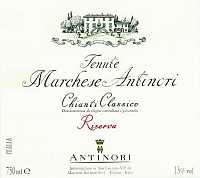
|
|
Chianti Classico Riserva Tenute Marchese Antinori 2000 |
|
| Antinori (Italy) | |
| Grapes: Sangiovese (90%), Cabernet Sauvignon (10%) | |
| Price: n.a. | Score: |
| This Chianti shows an intense ruby red color and nuances of garnet red, little transparency. The nose denotes intense, clean, pleasing and refined aromas that start with hints of plum and black cherry jam followed by aromas of blueberry jam, pomegranate, dried violet, vanilla, licorice, tobacco, carob and pink pepper. In the mouth has good correspondence to the nose, a slightly tannic attack and however well balanced by alcohol, full body, intense flavors, good tannins, agreeable. The finish is persistent with flavors of plum and black cherry jam. This Chianti ages for 14 months in barrique followed by at least 12 months of aging in bottle. | |
| Food Match: Braised and stewed meat with mushrooms, Roasted meat, Game, Hard cheese | |
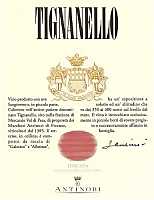
|
|
Tignanello 2001 |
|
| Antinori (Italy) | |
| Grapes: Sangiovese (85%), Cabernet Sauvignon (10%), Cabernet Franc (5%) | |
| Price: n.a. | Score: |
| This wine shows an intense ruby red color and nuances of garnet red, little transparency. The nose reveals intense, clean, pleasing, refined and elegant aromas which start with hints of black cherry, plum and blueberry followed by aromas of blackberry, vanilla, dried violet, licorice, tobacco, pink pepper, cocoa, cinnamon, eucalyptus and bell pepper. In the mouth has very good correspondence to the nose, a tannic attack and however well balance by alcohol, full body, intense flavors, good tannins, agreeable. The finish is very persistent with long flavors of plum, black cherry and blueberry. A very well made wine. Tignanello ages for 14 months in barrique followed by 12 months of aging in bottle. | |
| Food Match: Game, Roasted meat, Stewed and braised meat, Hard cheese | |
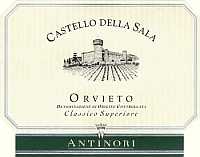
|
|
Orvieto Classico Superiore 2003 |
|
| Castello della Sala (Italy) | |
| Grapes: Procanico (40%), Grechetto (27%), Verdello (15%), Drupeggio, Malvasia (3%), Chardonnay (15%) | |
| Price: n.a. | Score: |
| The wine shows a brilliant straw yellow color and nuances of greenish yellow, very transparent. The nose reveals intense, clean, pleasing and refined aromas which start with hints of broom, pear and plum followed by aromas of pineapple, litchi, apple, grapefruit and hawthorn. In the mouth has good correspondence to the nose, a crisp attack and however balanced by alcohol, good body, intense flavors, agreeable. The finish is persistent with flavors of apple, plum and pineapple. This wine ages in steel tanks. | |
| Food Match: Fried fish, Sauteed fish, Pasta and risotto with fish and crustaceans | |
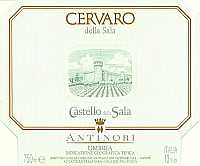
|
|
Cervaro della Sala 2002 |
|
| Castello della Sala (Italy) | |
| Grapes: Chardonnay (80%), Grechetto (20%) | |
| Price: n.a. | Score: |
| This wine shows a brilliant golden yellow color and nuances of golden yellow, very transparent. The nose reveals personality with intense, clean, pleasing, refined and elegant aromas which start with hints of quince, banana, hawthorn and toasted wood followed by aromas of acacia, pineapple, honey, mineral, hazelnut, pear, grapefruit and coffee. In the mouth has very good correspondence to the nose, a crisp attack and however well balanced by alcohol, good body, intense flavors, agreeable. The finish is very persistent with long flavors of quince, banana, pineapple and grapefruit. A very well made white wine. Cervaro della Sala ferments and ages in barrique for 5 months followed by 10 months of aging in bottle. | |
| Food Match: Roasted fish, Stuffed pasta, Roasted white meat, Stewed fish | |
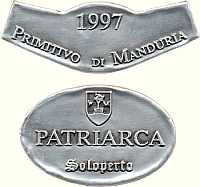
|
|
Primitivo di Manduria Patriarca 1997 |
|
| Soloperto (Italy) | |
| Grapes: Primitivo | |
| Price: € 20.50 | Score: |
| The wine shows an intense ruby red color and nuances of garnet red, little transparency. The nose reveals intense, clean, pleasing and refined aromas which start with hints of plum jam, blackberry jam and black cherry jam followed by aromas of carob, blackberry jam, licorice, vanilla and hints of star anise. In the mouth has good correspondence to the nose, a slightly tannic attack and however balanced by alcohol, full body, intense flavors, good tannins. The finish is persistent with flavors of plum jam and blackberry jam. This Primitivo ages for 9 months in barrique and for at least 2 years in cask. | |
| Food Match: Stewed and braised meat, Roasted meat, Game, Hard cheese | |

|
|
Primitivo di Manduria Rubinum 1998 |
|
| Soloperto (Italy) | |
| Grapes: Primitivo | |
| Price: € 7.50 | Score: |
| This Primitivo shows an intense ruby red color and nuances of garnet red, little transparency. The nose reveals intense, clean, pleasing and refined aromas which start with hints of plum jam, black cherry jam and blackberry jam followed by aromas of dried violet, vanilla, licorice, tobacco, cocoa, cinnamon and cinchona. In the mouth has good correspondence to the nose, a slightly tannic attack with good smoothness and pleasing hints of sweetness, however balanced by alcohol, full body, intense flavors, good tannins, agreeable. The finish is persistent with flavors of plum jam and blackberry jam. A well made wine. This Primitivo ages in cask for at least 2 years. | |
| Food Match: Stewed and braised meat, Roasted meat, Hard cheese | |
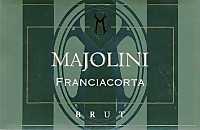
|
|
Franciacorta Brut |
|
| Majolini (Italy) | |
| Grapes: Chardonnay, Pinot Noir | |
| Price: € 15.60 | Score: |
| This wine shows an intense straw yellow color and nuances of straw yellow, very transparent, good effervescence, fine and persistent perlage. The nose reveals intense, clean, pleasing and refined aromas which start with hints of plum, praline and banana followed by aromas of acacia, hawthorn, kiwi, bread crust, apple, hazelnut and grapefruit. In the mouth has good correspondence to the nose, a crisp and effervescent attack, however balanced, good body, intense flavors, agreeable. The finish is persistent with flavors of kiwi and apple. The Chardonnay used for the base wine ages in barrique. This Franciacorta ages on its lees for at least 24 months. | |
| Food Match: Fried fish, Pasta and risotto with fish and crustaceans, Broiled fish and crustaceans | |
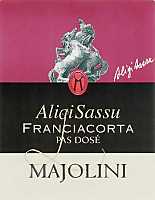
|
|
Franciacorta Pas Dosé Aligi Sassu 1999 |
|
| Majolini (Italy) | |
| Grapes: Chardonnay | |
| Price: € 20.30 | Score: |
| This Franciacorta shows a brilliant straw yellow color and nuances of straw yellow, very transparent, good effervescence, fine and persistent perlage. The nose reveals intense, clean, pleasing and refined aromas which start with hints of plum and honey followed by aromas of banana, hawthorn, yeast, marzipan, bread crust, pear and apple. In the mouth has good correspondence to the nose, an effervescent and crisp attack, however well balanced, good body, intense flavors, agreeable. The finish is persistent with flavors of apple, pear and plum. A well made wine. This Franciacorta ages in the bottle on its lees for at least 30 months. | |
| Food Match: Pasta and risotto with fish and crustaceans, Broiled fish and crustaceans, Fish appetizers | |
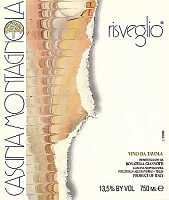
|
|
Risveglio 2000 |
|
| Cascina Montagnola (Italy) | |
| Grapes: Chardonnay | |
| Price: € 18.00 | Score: |
| This wine shows a pale golden yellow color and nuances of straw yellow, very transparent. The nose reveals good personality with intense, clean, pleasing and refined aromas that start with hints of hazelnut, passion fruit and vanilla followed by aromas of praline, grapefruit, banana, acacia, hawthorn, apple and plum. In the mouth has good correspondence to the nose, a crisp attack and however balanced, good body, intense flavors, agreeable. The finish is persistent with flavors of plum, banana and passion fruit. A well made wine. Risveglio ages for 6 months in cask. | |
| Food Match: Roasted fish, Stewed fish, Roasted white meat, Stuffed pasta | |
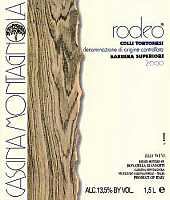
|
|
Colli Tortonesi Barbera Superiore Rodeo 2000 |
|
| Cascina Montagnola (Italy) | |
| Grapes: Barbera | |
| Price: € 16.00 | Score: |
| This Barbera shows a brilliant ruby red color and nuances of garnet red, little transparency. The nose reveals good personality with intense, clean, pleasing and refined aromas which start with hints of plum, pomegranate and blackberry followed by aromas of vanilla, violet, cyclamen, blueberry, black cherry, licorice, tobacco, cocoa and eucalyptus. In the mouth has good correspondence to the nose, a slightly tannic attack and pleasing crispness, however well balanced by alcohol, full body, intense flavors, good tannins. The finish is persistent with flavors of pomegranate, black cherry, plum and blackberry. A well made wine. This Barbera ages for 12-14 months in cask. | |
| Food Match: Game, Roasted meat, Stewed and braised meat with mushrooms, Hard cheese | |
|
||||||||
|
DiWineTaste Polls
|
| |||||||
Privacy Policy | |||||||


| Copyright © 2002-2024 Antonello Biancalana, DiWineTaste - All rights reserved |
| All rights reserved under international copyright conventions. No part of this publication and of this WEB site may be
reproduced or utilized in any form or by any means, electronic or mechanical, without permission in writing from DiWineTaste. |